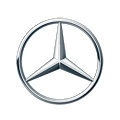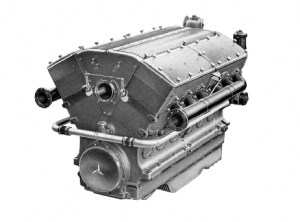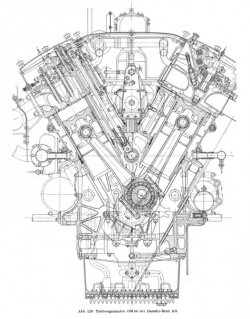OM 86
Tilbake til oversikt over Mercedesmotorer
Mercedes Benz OM 86
Den 12 sylindrede firetakts dieselmotoren Mercedes-Benz OM 86 var en hurtigløpende motor tatt frem for å brukes i raske motorvogner tilhørende Deutsche Reichsbahn. Motoren var i bruk fra 1937, og ble allerede i 1938 erstattet av MB 806.
Pressemelding fra 1946.
Der auf der Exportsohau gezeigte
Mercedes Benz Triebwagen Dieselmotor "Typ OM 86"
ist mit seiner Dauerleistung von 450 PS als. Kraftquelle für grosse Schnelltriebwagen bestimmt. Er arbeitet nach dem Daimler-Benz- Vorkämmer-Verfehren. Auf gute Zugänglichkeit aller Organe ist besonderer Wert gelegt. Die
gedrungenen Hauptabmessungen des "OM 86" erlauben ohne weiteres, dass er auch im Drehgestell des Triebwagens eingebaut werden kann.
T e c h n i s c h e B e s c h r e i b u n g:
Der Mercedes Benz Triebwagen Dieselmotor "Typ OM 86" ist ein Zwölfzylinder - zweireihig in V-Form -, die Bohrung des einzelnen Zylinders beträgt 165 mm, der Hub 195 mm, sodass sich ein Gesamtinhalt von 50,035 Liter. -
Das Leichtmetall-Kurbelgehäuse ist besonders stieif ausgebildet. -
Die äusserst kräftig ausgeführte Kurbelwelle aus Spezlalstahl hat nach besonderem Verfahren gehärtete Lagerfläohen
und ist siebenmal gelagert. Je drei Arbeltszylinder sind zu einem Graugüseblock vereinigt. Die Zylinderlaufbüchsen sind austausbar. -
.
Die Kolben, aus einer Leichtmetall-Legierung bestehend, tragen fünf Dichtungsringe und zwei Ölabstreifringe. -
Die aus Spezlalstahl gefertigten Pleuelstangen haben Doppel-T-Querschnitt. -
Die Zylinderköpfe bestehen aus chromnickellegiertem Grauguss. Der Zylinderkopf enthält für jeden Arbeitszylinder zwei Einlass- und
zwei Auslass-Ventile und eine zwischen diesem Ventilen angeordnete Treiböl-Einspritzdüse sowie die zur Einleitung der Zündung erforderliche Vorkammer. -
Die hängend angeordneten Ventile werden durch Rollenstössel und Kipphebel von der im Kurbelgehäuse-Oberteil gelagerten
Höokenwelle gesteuert. -
Die Nockenwelle wird vom hinteren Ende der Kurbelwelle durch sohräg-verzahnt Stirnräder schwingungsfrei angetrieben. -
Die Einleitung der Zündung erfolgt in der Vorkammer durch die übör die Selbstentzündungs-Temperatur des i
Treiböles verdichtete Luft. -
Das Anlassen des Motors geschieht in der Regel über den Elektro-Generator. Es kann jedoch unter Umständen auch
auf jeder Motorseite ein grosser Bosoh-Anlasser eingebaut werden. -
Zwei sechszylindrige Bosoh-Einspritzpumpen sind im V-Raum des Motors gut zugänglich angeordnet, -
Die Kühlwasserpumpe ist auf der Sohwungradseite des Motors untergebracht. -
Die Sohmierölpumpe erhält ihren Antrieb vom hinteren Ende der Kurbelwelle und besteht, aus zwei in einem Gehäuse vereinigten
Zahnradpumpen. Die Ölwanne, die als Ölvorratsbehälter dient, fasst 65 Liter Öl. -
Für beide Treiböl-Einöpritzpumpen ist ein gemeinsamer Regler vorgesehen Mit dem Regler kombiniert ist auch die Verstelllung des Einspritzzeitpunktes. -
Als Treiböle können für den Motor fast alle reinen mineralischen und pflanzlichen Rohöle: Gasöl, Braunkohlenteeröl, Paraffinöl, Texasöl, Petroleum usw. verwendet werden. -
Leistung und Verbrauch:
Dauerleistung bei etwa 1400 Umär./Min. . . . . . . . . . . .450 PS
Mittlere Kölbengeschwindigkeit bei Dauerleistung . . . 9,10 m/Sek.
Kraftstoffverbrauch . . . . . . . . . . . . . . . . . . . . . . . . . . . . 190 gr pro PS/Std
Schmierölverbrauch . . . . . . . . . . . . . . . . . . . . . . . . . . . . 6-8 gr pro PS/Std
Masse und Gewichte:
Grösste Länge . . . . . . . . . . . . . . . . . . . . . . . . . . . . . 1850 mm
Grösste Breite . . . . . . . . . . . . . . . . . . . . . . . . . . . . . 1110 mm
Fundament breite . . . . . . . . . . . . . . . . . . . . . . . . . . . 670 mm
Grösste Höhe . . . . . . . . . . . . . . . . . . . . . . . . . . . . . .1058 mm
Grösste Tiefe (unter Mitte der Kurbelwelle) . . . . . . . . 450 mm
Gewicht in üblicher Ausstattung (trocken) . . . . . . . . 2400 kg
Spezifisches Gewicht je PS bei Dauerleistung ca . . . .5,3 kg
Engelsk versjon (marskinoversatt)
The one shown at the Exportsohau
Mercedes Benz railcar diesel engine "Type OM 86"
is with its continuous output of 450 hp. Power source intended for large express railcars. It works according to the Daimler-Benz pre-combustion method. Particular importance is attached to good accessibility of allservice parts. The
The compact main dimensions of the "OM 86" easily allow it to be installed in the bogie of the railcar.
T e c h n i c a l d e s c r i p t i o n:
The Mercedes Benz railcar diesel engine "Type OM 86" is a twelve-cylinder - two-row V-shaped - the bore of the individual cylinder is 165 mm and the stroke is 195 mm, resulting in a total capacity of 50,035 liters. -
The light metal crankcase is particularly rigid. -
The extremely strong crankshaft made of special steel has bearing surfaces hardened using a special process and is supported seven times. Three working cylinders are combined to form a gray iron block. The cylinder liners are replaceable. -
The pistons, made of a light metal alloy, have five sealing rings and two oil scraper rings. -
The connecting rods made of special steel have a double-T cross-section. -
The cylinder heads are made of chrome alloy gray cast iron. The cylinder head contains two inlet and two outlet valves for each working cylinder and a fuel oil injection nozzle arranged between these valves as well as the antechamber required to initiate ignition. -
The suspended valves are controlled by roller tappets and rocker arms from the top shaft mounted in the upper part of the crankcase. -
The camshaft is driven vibration-free from the rear end of the crankshaft by sorge-toothed spur gears. Ignition is initiated in the antechamber by air compressed above the self-ignition temperature of the fuel oil. -
The engine is usually started via the electric generator. However, under certain circumstances, a large Bosoh starter can be installed on each side of the engine. -
Two six-cylinder Bosoh injection pumps are located in the V-space of the engine for easy access. -
The cooling water pump is located on the engine side of the engine. -
The lubricating oil pump receives its drive from the rear end of the crankshaft and consists of two gear pumps combined in one housing. The oil pan, which serves as an oil storage container, holds 65 liters of oil. -
A common controller is provided for both fuel oil injection pumps. The controller also combines the adjustment of the injection timing. -
Almost all pure mineral and vegetable crude oils can be used as fuel oils for the engine: gas oil, brown coal tar oil, paraffin oil, Texas oil, petroleum, etc. -
Performance and consumption:
Continuous performance at around 1400 cycles/min. . . . . . . . . . . .450 hp
Medium. Piston speed at continuous power. . . . . . . . . . . . . . . . . . 9.10 m/sec.
Fuel consumption. . . . . . . . . . . . . . . . . . . . . . . . . . . . . . . . . . . . . . .190 gr per hp/hour
Lubricating oil consumption. . . . . . . . . . . . . . . . . . . . . . . . . . . . . . . 6-8 grams per hp/hour
Mass and weight:
Greatest length. . . . . . . . . . . . . . . . . . . . . . . . . . . . . . . . . . . . . . .1850 mm
Largest width. . . . . . . . . . . . . . . . . . . . . . . . . . . . . . . . . . . . . . . . .1110 mm
Foundation width. . . . . . . . . . . . . . . . . . . . . . . . . . . . . . . . . . . . . .670 mm
Greatest height. . . . . . . . . . . . . . . . . . . . . . . . . . . . . . . . . . . . . . 1058 mm
Largest depth (below the center of the crankshaft). . . . . . . . . . . .450 mm
Weight in usual equipment (dry). . . . . . . . . . . . . . . . . . . . . . . . . 2400 kg
Specific weight per horsepower at continuous output approx. . . . 5.3 kg


